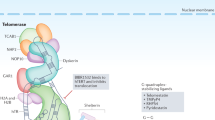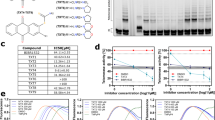Abstract
Telomerase is a ribonucleoprotein complex that maintains the stability of chromosome ends and regulates replicative potential. Telomerase is upregulated in over 85% of human tumors, but not in adjacent normal tissues and represents a promising target for anticancer therapy. Most telomerase-based therapies rely on the inhibition of telomerase activity and require extensive telomere shortening before inducing any antiproliferative effect. Disturbances of telomere structure rather than length may be more effective in inducing cell death. Telomerase RNA subunits (hTRs) with mutations in the template region reconstitute active holoenzymes that incorporate mutated telomeric sequences. Here, we analysed the feasibility of an anticancer approach based on the combination of telomere destabilization and conventional chemotherapeutic drugs. We show that a mutant template hTR dictates the synthesis of mutated telomeric repeats in telomerase-positive cancer cells, without significantly affecting their viability and proliferative ability. Nevertheless, the mutant hTR increased sensitivity to anticancer drugs in cells with different initial telomere lengths and mechanisms of telomere maintenance and without requiring overall telomere shortening. This report is the first to show that interfering with telomere structure maintenance in a telomerase-dependent manner may be used to increase the susceptibility of tumor cells to anticancer drugs and may lead to the development of a general therapy for the treatment of human cancers.
This is a preview of subscription content, access via your institution
Access options
Subscribe to this journal
Receive 50 print issues and online access
$259.00 per year
only $5.18 per issue
Buy this article
- Purchase on Springer Link
- Instant access to full article PDF
Prices may be subject to local taxes which are calculated during checkout






Similar content being viewed by others
References
Brown JM, Attardi LD . (2005). Nat Rev Cancer 5: 231–237.
Bryan TM, Englezou A, Dalla Pozza L, Dunham MA, Reddel RR . (1997). Nat Med 3: 1271–1274.
Bryan TM, Englezou A, Gupta J, Bacchetti S, Reddel RR . (1995). EMBO J 14: 4240–4248.
Castedo M, Perfettini JL, Roumier T, Andreau K, Medema R, Kroemer G . (2004). Oncogene 23: 2825–2837.
Cerone MA, Londono-Vallejo JA, Bacchetti S . (2001). Hum Mol Genet 10: 1945–1952.
Chen Z, Koeneman KS, Corey DR . (2003). Cancer Res 63: 5917–5925.
Christodoulopoulos G, Malapetsa A, Schipper H, Golub E, Radding C, Panasci LC . (1999). Clin Cancer Res 5: 2178–2184.
Chung HK, Cheong C, Song J, Lee HW . (2005). Curr Mol Med 5: 233–241.
Cimino-Reale G, Pascale E, Battiloro E, Starace G, Verna R, D'Ambrosio E . (2001). Nucleic Acids Res 29: E35.
Collins K, Mitchell JR . (2002). Oncogene 21: 564–579.
Dunham MA, Neumann AA, Fasching CL, Reddel RR . (2000). Nat Genet 26: 447–450.
Feng J, Funk WD, Wang S-S, Weinrich SL, Avilion AA, Chiu C-P et al (1995). Science 269: 1236–1241.
Folini M, De Marco C, Orlandi L, Daidone MG, Zaffaroni N . (2000). Eur J Cancer 36: 2137–2145.
Guiducci C, Cerone MA, Bacchetti S . (2001). Oncogene 20: 714–725.
Hahn WC, Stewart SA, Brooks MW, York SG, Eaton E, Kurachi A et al (1999). Nat Med 5: 1164–1170.
Harley CB, Futcher AB, Greider CW . (1990). Nature 345: 458–460.
Herbert B-S, Pitts AE, Baker SI, Hamilton SE, Wright WE, Shay JW et al (1999). Proc Natl Acad Sci USA 96: 14276–14281.
Jordan MA, Toso RJ, Thrower D, Wilson L . (1993). Proc Natl Acad Sci USA 90: 9552–9556.
Karlseder J, Broccoli D, Dai Y, Hardy S, de Lange T . (1999). Science 283: 1321–1325.
Kelland LR . (2005). Eur J Cancer 41: 971–979.
Kim MM, Rivera MA, Botchkina IL, Shalaby R, Thor AD, Blackburn EH . (2001). Proc Natl Acad Sci USA 98: 7982–7987.
Kim NW, Piatyszek MA, Prowse KR, Harley CB, West MD, Ho PLC et al (1994). Science 266: 2011–2015.
Kirk KE, Harmon BP, Reichardt IK, Sedat JW, Blackburn EH . (1997). Science 275: 1478–1481.
Kondo Y, Kondo S, Tanaka Y, Haqqi T, Barna BP, Cowell JK . (1998). Oncogene 16: 2243–2248.
Lee K-H, Rudolph KL, Ju Y-J, Greenberg RA, Cannizzaro L, Chin L et al (2001). Proc Natl Acad Sci USA 98: 3381–3386.
Li S, Rosenberg JE, Donjacour AA, Botchkina IL, Hom YK, Cunha GR et al (2004). Cancer Res 64: 4833–4840.
Lin J, Smith DL, Blackburn EH . (2004). Mol Cell Biol 15: 1623–1634.
Ludwig A, Saretzki G, Holm PS, Tiemann F, Lorenz M, Emrich T et al (2001). Cancer Res 61: 3053–3061.
Marusic L, Anton M, Tidy A, Wang P, Villeponteau B, Bacchetti S . (1997). Mol Cell Biol 17: 6394–6401.
Masutomi K, Possemato R, Wong JM, Currier JL, Tothova Z, Manola JB et al (2005). Proc Natl Acad Sci USA 102: 8222–8227.
Masutomi K, Yu EY, Khurts S, Ben-Porath I, Currier JL, Metz GB et al (2003). Cell 114: 241–253.
Misawa M, Tauchi T, Sashida G, Nakajima A, Abe K, Ohyashiki JH et al (2002). Int J Oncol 21: 1087–1092.
Nakamura M, Masutomi K, Kyo S, Hashimoto M, Maida Y, Kanaya T et al (2005). Hum Gene Ther 16: 859–868.
Park KH, Rha SY, Kim CH, Kim TS, Yoo NC, Kim JH et al (1998). Int J Oncol 13: 489–495.
Sharma GG, Gupta A, Wang H, Scherthan H, Dhar S, Gandhi V et al (2003). Oncogene 22: 131–146.
Shay JW, Bacchetti S . (1997). Eur J Cancer 33: 787–791.
Shin KH, Kang MK, Dicterow E, Kameta A, Baluda MA, Park NH . (2004). Clin Cancer Res 10: 2551–2560.
Smith CD, Blackburn EH . (1999). J Cell Biol 145: 203–214.
Stewart SA, Ben-Porath I, Carey VJ, O'Connor BF, Hahn WC, Weinberg RA . (2003). Nat Genet 33: 492–496.
Takai H, Smogorzewska A, de Lange T . (2003). Curr Biol 13: 1549–1556.
Tentori L, Portarena I, Barbarino M, Balduzzi A, Levati L, Vergati M et al (2003). Mol Pharm 63: 192–202.
Ward RJ, Autexier C . (2005). Mol Pharm 68: 779–786.
Wen J, Cong YS, Bacchetti S . (1998). Hum Mol Genet 7: 1137–1141.
Xu L, Blackburn EH . (2004). J Cell Biol 167: 819–830.
Yu G-L, Bradley JD, Attardi LD, Blackburn EH . (1990). Nature 344: 126–132.
Zhang X, Mar V, Zhou W, Harrington L, Robinson MO . (1999). Genes Dev 13: 2388–2399.
Acknowledgements
We thank Dr Silvia Bacchetti for cell lines, constructs and for comments on the manuscript, Dr Sun Young Rha for cell lines, Dr Koromilas for the anti-p53 antibody and Graeme Nimmo for technical help with the FACS and critical discussion. This work was funded by Canadian Institute of Health Research IAO-64655 and Cancer Research Society Inc. grants to CA and by a Grant from l'Association pour la Recherche contre le Cancer to AL-V. CA is a chercheur-boursier of the Fonds de la Recherche on Santé du Quebec. MAC is supported by a US Army Department of Defense Breast Cancer Research Program Award.
Author information
Authors and Affiliations
Corresponding author
Additional information
Supplementary Information accompanies the paper on Oncogene website (http://www.nature.com/onc).
Rights and permissions
About this article
Cite this article
Cerone, M., Londoño-Vallejo, J. & Autexier, C. Mutated telomeres sensitize tumor cells to anticancer drugs independently of telomere shortening and mechanisms of telomere maintenance. Oncogene 25, 7411–7420 (2006). https://doi.org/10.1038/sj.onc.1209727
Received:
Revised:
Accepted:
Published:
Issue Date:
DOI: https://doi.org/10.1038/sj.onc.1209727
Keywords
This article is cited by
-
Highly efficient radiosensitization of human glioblastoma and lung cancer cells by a G-quadruplex DNA binding compound
Scientific Reports (2015)
-
Telomerase as a useful target in cancer fighting—the breast cancer case
Tumor Biology (2013)
-
Telomere and Telomerase as Targets for Cancer Therapy
Applied Biochemistry and Biotechnology (2010)
-
Lipid-conjugated telomerase template antagonists sensitize resistant HER2-positive breast cancer cells to trastuzumab
Breast Cancer Research and Treatment (2009)



